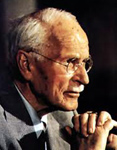 In Modern Man in Search of a Soul, C.G. Jung examines how psychic archetypes guide the individual psyche towards wholeness:
In Modern Man in Search of a Soul, C.G. Jung examines how psychic archetypes guide the individual psyche towards wholeness:
When first I took this direction I did not know where it would lead. I did not know what lay hid in the depths of the psyche—that region which I have since called the “collective unconscious”, and whose contents I designate as “archetypes.” Since time immemorial, eruptions of the unconscious have taken place, and ever and again they have repeated themselves. Consciousness did not exist from the beginning, and in every child it has to be built up anew in the first years of life. Consciousness is very weak in this formative period, and history shows us that the same is true of mankind—the unconscious easily seizes power.
These struggles have left their marks. To put it in scientific terms: instinctive defence-mechanisms have been developed which automatically intervene when the danger is greatest, and their coming into action is represented in fantasy by helpful images which are ineradicably fixed in the human psyche. These mechanisms come into play whenever the need is great. Science can only establish the existence of these psychic factors and attempt a rational explanation by offering an hypothesis as to their sources. This, however, only thrusts the problem a stage back and in no way answers the riddle. We thus come to those ultimate questions: Whence does consciousness come? What is the psyche? And at this point all science ends.
It is as though, at the culmination of the illness, the destructive powers were converted into healing forces. This is brought about by the fact that the archetypes come to independent life and serve as spiritual guides for the personality, thus supplanting the inadequate ego with its futile willing and striving. As the religious-minded person would say: guidance has come from God. With most of my patients I have to avoid this formulation, for it reminds them too much of what they have to reject. I must express myself in more modest terms, and say that the psyche has awakened to spontaneous life. And indeed this formula more closely fits the observable facts. The transformation takes place at that moment when in dreams or fantasies themes appear whose source in consciousness cannot be shown. To the patient it is nothing less than a revelation when, from the hidden depths of the psyche, something arises to confront him—something strange that is not the “I” and is therefore beyond the reach of personal caprice. He has gained access to the sources of psychic life, and this marks the beginning of the cure.
Excerpt from the Carl Jung ebook, Modern Man in Search of a Soul